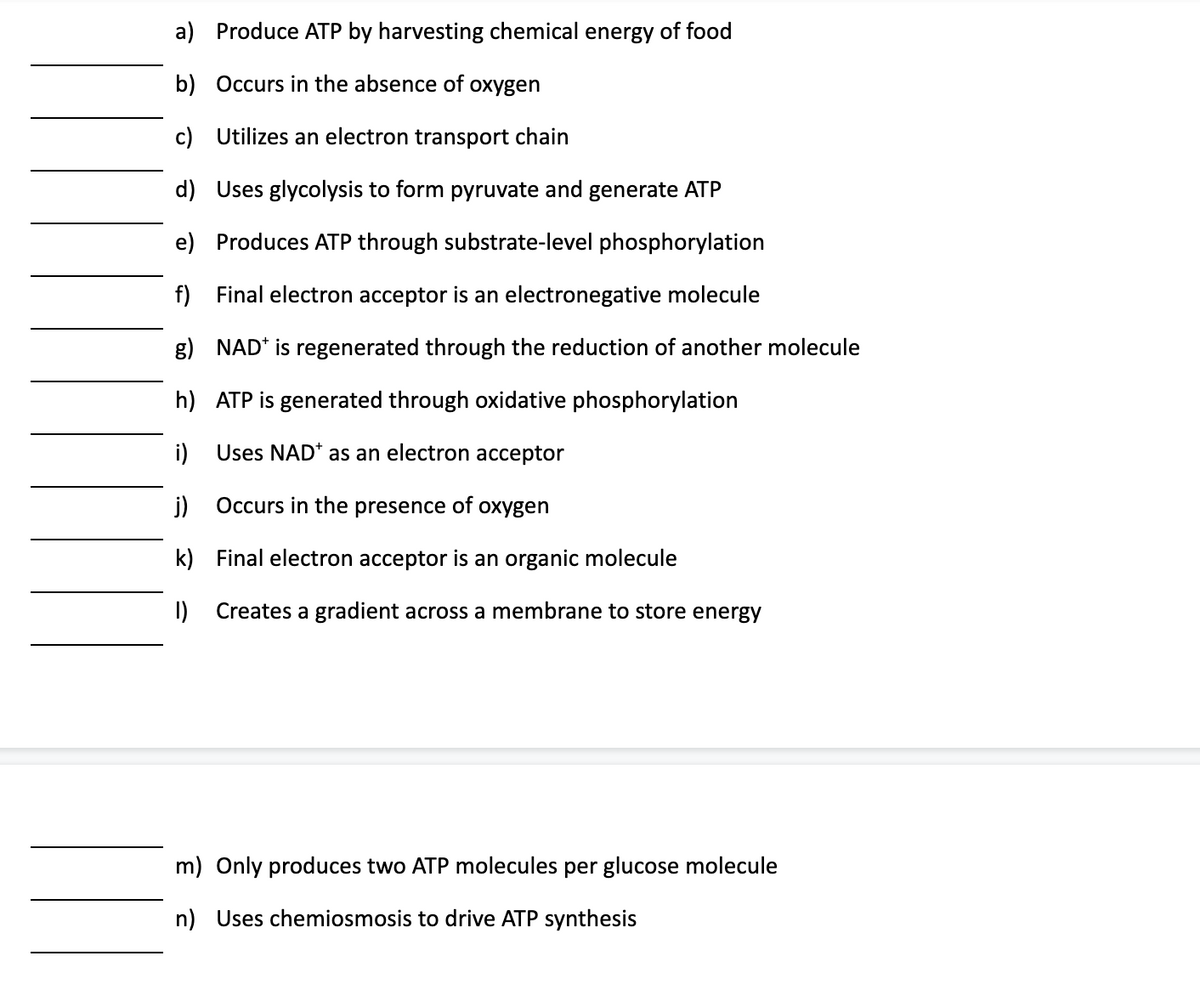Biology: The Unity and Diversity of Life (MindTap Course List)
14th Edition
ISBN:9781305073951
Author:Cecie Starr, Ralph Taggart, Christine Evers, Lisa Starr
Publisher:Cecie Starr, Ralph Taggart, Christine Evers, Lisa Starr
Chapter7: How Cells Release Chemical Energy
Section: Chapter Questions
Problem 6SQ: Which of the following reaction pathways is not part of the second stage of aerobic respiration? a....
Related questions
Question
q/16

Transcribed Image Text:16. For each statement below, indicate if it is true of aerobic cellular respiration, anaerobic cellular respiration,
fermentation, or a combination of the three. Note that some statements may describe two of the processes or
all three.
A. Aerobic cellular respiration
B. Anaerobic cellular respiration
C. Fermentation

Transcribed Image Text:a) Produce ATP by harvesting chemical energy of food
b) Occurs in the absence of oxygen
c) Utilizes an electron transport chain
d) Uses glycolysis to form pyruvate and generate ATP
e) Produces ATP through substrate-level phosphorylation
f) Final electron acceptor is an electronegative molecule
g) NAD* is regenerated through the reduction of another molecule
h) ATP is generated through oxidative phosphorylation
i) Uses NAD* as an electron acceptor
j) Occurs in the presence of
охудen
k) Final electron acceptor is an organic molecule
I) Creates a gradient across a membrane to store energy
m) Only produces two ATP molecules per glucose molecule
n) Uses chemiosmosis to drive ATP synthesis
Expert Solution
This question has been solved!
Explore an expertly crafted, step-by-step solution for a thorough understanding of key concepts.
Step by step
Solved in 2 steps

Knowledge Booster
Learn more about
Need a deep-dive on the concept behind this application? Look no further. Learn more about this topic, biology and related others by exploring similar questions and additional content below.Recommended textbooks for you

Biology: The Unity and Diversity of Life (MindTap…
Biology
ISBN:
9781305073951
Author:
Cecie Starr, Ralph Taggart, Christine Evers, Lisa Starr
Publisher:
Cengage Learning

Biology (MindTap Course List)
Biology
ISBN:
9781337392938
Author:
Eldra Solomon, Charles Martin, Diana W. Martin, Linda R. Berg
Publisher:
Cengage Learning

Biology 2e
Biology
ISBN:
9781947172517
Author:
Matthew Douglas, Jung Choi, Mary Ann Clark
Publisher:
OpenStax

Biology: The Unity and Diversity of Life (MindTap…
Biology
ISBN:
9781305073951
Author:
Cecie Starr, Ralph Taggart, Christine Evers, Lisa Starr
Publisher:
Cengage Learning

Biology (MindTap Course List)
Biology
ISBN:
9781337392938
Author:
Eldra Solomon, Charles Martin, Diana W. Martin, Linda R. Berg
Publisher:
Cengage Learning

Biology 2e
Biology
ISBN:
9781947172517
Author:
Matthew Douglas, Jung Choi, Mary Ann Clark
Publisher:
OpenStax

Biology: The Dynamic Science (MindTap Course List)
Biology
ISBN:
9781305389892
Author:
Peter J. Russell, Paul E. Hertz, Beverly McMillan
Publisher:
Cengage Learning